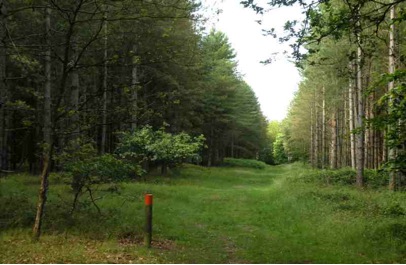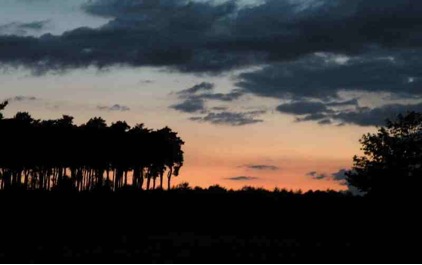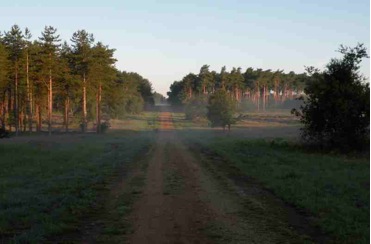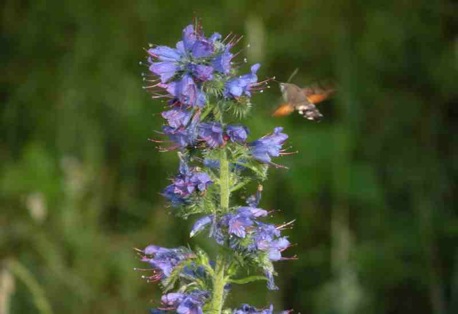Last week I visited Thetford Forest after a long break. It is a beautiful and unusual place. I went to work there in 1985 as felling was starting to break up a forest of solid maturing pine with limited views and little open space. Prior to planting it was more like a central European steppe than anything in England, a vast expanse of rabbit grazed drifting sand and shifting cultivation.
I started with a walk from the St Helens picnic site near Santon Downham and was delighted to find two families of Spotted Flycatchers, one of the sub-Saharan migrant species that has declined so dramatically. But I’d come to see an area newly replanted where I watched Woodlark in the early 1980s. Then the trees were less than 2 metres high. The picture shows them today, a very different scene!

How the Forest changes: these trees were newly replanted in 1982
Late June is when there are more birds than at any other time of year and the trees were full of Great Tit, Blue Tit, Goldcrest, Chaffinch and Coal Tit families. I also saw three Treecreepers during my visit.
Back to the Crown at Mundford for supper then out again to the Mundford area of the forest.

Nightjar time in Thetford Forest
I was looking for Thetford’s signature bird, the Nightjar, which moved into the new clearfells in the 1980s. Now there are over 200 pairs and a bird on the slide nationally has rallied and increased over the last 20 years. At 9.43, as dusk closed in, a Woodcock roded over making its strange croaking call. Just a minute later a Nightjar started to ‘Churr’, the extraordinary , unmistakeable whirring, chainsaw like sound, rising and falling as the bird turns its head. Half an hour later I’d heard 5 different birds.

Mist rises from the early morning forest near Mundford
I was back at 5.30 the next morning for a long walk. What really struck me was how the forest has changed: so varied, with a complete mix of different ages of pines and lots of broadleaves, too. I stopped to study a line of elm, some healthy but others clearly caught by Dutch Elm Disease. Ramming home the disease message, many Corsican Pine were very short of needles, struck by the new disease Red Band Needle Blight. Rides are wider and there are swathes of open grassland and clumps of young birch trees making for a quite exceptional forest, so much so that the Thetford based British Trust for Ornithology has said the forest is the best place in East Anglia for woodland birds, but also for heathland and farmland birds as the trilling Yellowhammers kept emphasising !
I got very close to a very young Roe Deer and came across one of my favourite insects feeding on one of my favourite flowers, in the picture below.

Hummingbird Hawk Moth feeding on Vipers Bugloss
Back in Santon Downham, my old friend Ron Hoblyn told me of his concern over the decline in so many birds despite the pristine environment of the forest. The Spotted Flycatchers are gone from his garden and the Nightingales from the nearby forest. I didn’t hear one Turtle Dove, for which the Forest has always been a stronghold.
Finally, I met up with Anne Mason, Chairman of the Friends of Thetford Forest. It was a great meeting: Anne and the friends, with over 1,000 members, are passionate about National ownership. I was amazed to discover just how clearly Anne understood what the forest is about, especially the skilled planning and balancing the Forestry Commission does to optimise so many values in a forest of huge biodiversity value, equally popular with locals and visitors and a big timber producer. The Friends are totally committed to National ownership of our National Forests and want the Forestry Commission to go on managing them. They’d like to see their excellent local liaison given a more formal footing to confirm what they already know, that we all own the National Forests.
Roderick Leslie
Retired head of policy at the Forestry Commission, Rod worked for the FC for over 35 years. In his time as a forester, he not only worked in Field management & Conservation policy but was also the commission’s Private forestry & Environment officer for the South and West of England.
Rod is a keen ornithologist and expert on the critically endangered Nightjar. His book ‘Birds and Forestry‘ (co-authored with Mark Avery, RSPB Conservation director), is acclaimed as a step toward sustainable forestry planning. Tackling the issues between forestry and nature conservation. Rod is a founder member of Our Forests!



























Great to hear Rod’s comments, i have spent 38 years working for the FC and last year returned to my home forest after a 25 year abscence, also like rod i was struck by the difference the breaking of a Pine monoculture has made, this must only develop in the future with the replacement species for the diseased corsican pine being varied and containing several broadleaved species.
The FC has the passionate workforce to see through these changes if left to see them through, sadly i fear for this passion as it is eroded by endless cuts in budget and people numbers.
Next time you are down Rod look an old colleague up and i will be happy to show you around.
Great to see this article appreciating Thetford Forest and the excellent work of the Forestry Commission and the Friends of Thetford Forest Park. I have fairly recently got to know Thetford Forest and I appreciate its variety and beauty.
It is particularly good to see you publicising the support and clear position of the Friends for keeping the Forestry Commission running our public forests — as an excellent example of true ‘big society’ values they understand that they need the professionals in place to work with them.
The Friends also understand very clearly the potential impact of the drastic cuts the Forestry Commission is being forced to make by the government, and on their excellent website they make this clear. http://saveourforests.fotfp.org.uk/
Forestry Commission staff in Thetford Forest (and the rest of East Anglia and the rest of England) do very valuable work, often working with voluntary organisations and other bodies, and this is under severe threat from the 25% cuts. Ironically these are going to take effect before the panel even gives its initial report let alone makes recommendations and there is time for the government to consider them. That means that the work of the forestry panel is pre-empted and undermined. Strangely I’m not sure that the panel is taking this on board and making this point, other than perhaps some oblique comments from the Bishop.
It is therefore crucial that we all make these points are very strongly to the forestry panel — via the DEFRA website http://www.defra.gov.uk/rural/forestry/panel or online via Save Our Woods http://saveourwoods.co.uk/respond-to-the-forestry-panel/
But hurry up — you only have until the end of July!